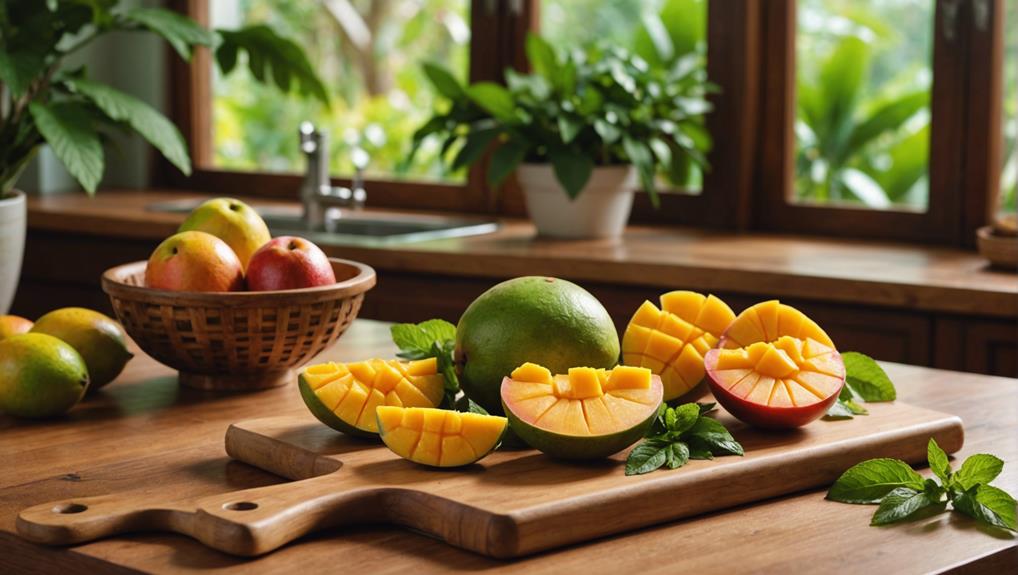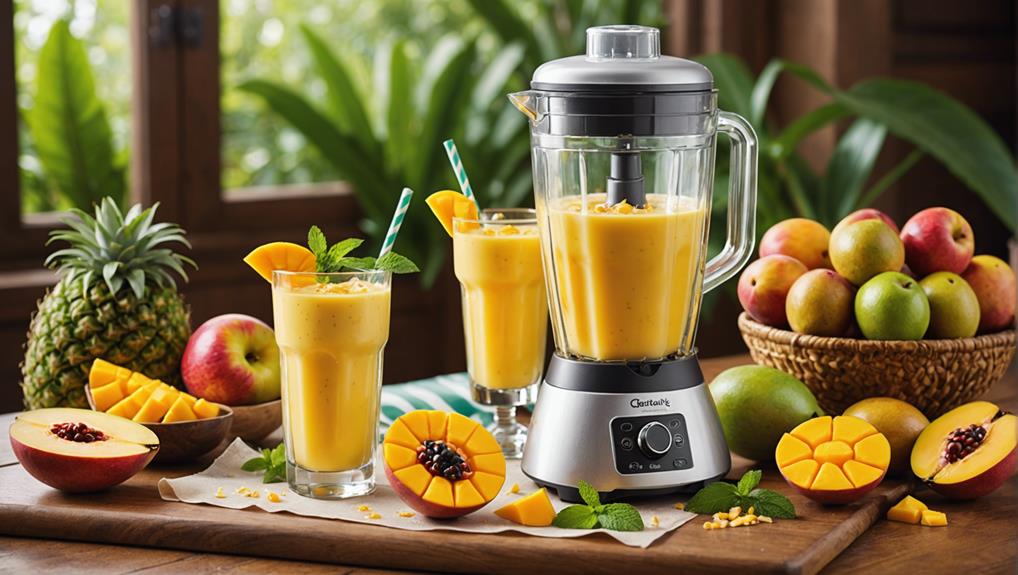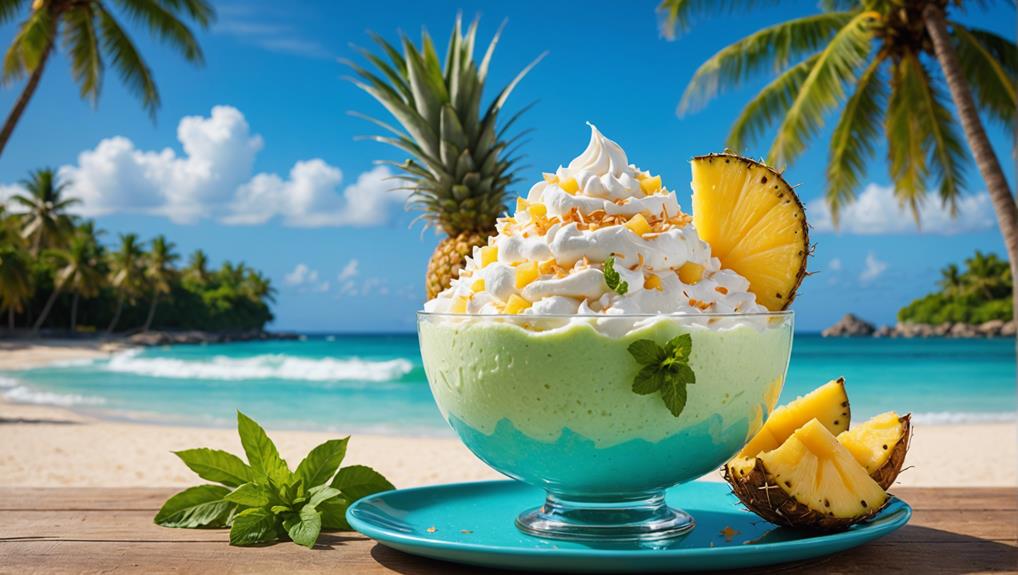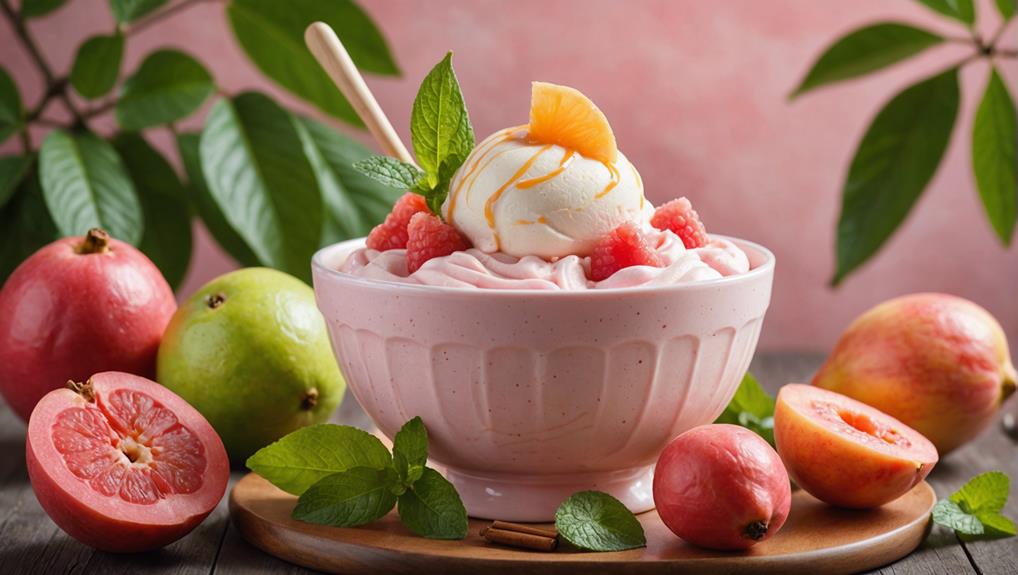To craft a Mango Frozen Yogurt, blend 2 cups of fresh mango puree, 1 cup of plain Greek yogurt, 1/2 cup of granulated sugar, 1 tablespoon lemon juice, and a pinch of salt. Choose ripe mangoes like Ataulfo and avoid fibrous sections. Whisk the yogurt base, ensuring even consistency. Blend the mango puree and yogurt mixture for 2-3 minutes in a high-speed blender. Freeze in airtight containers for 4-6 hours, stirring every 30 minutes initially. Serve in chilled bowls, garnished with mango or mint for a perfect tropical treat. Discover more tips for impeccable results and presentation.
Key Takeaways
- Combine 2 cups mango puree with 1 cup Greek yogurt, 1/2 cup sugar, 1 tbsp lemon juice, and a pinch of salt.
- Blend the mixture until smooth, then freeze in an airtight container for 4-6 hours, stirring every 30 minutes initially.
- Use ripe Ataulfo, Haden, or Alphonso mangoes, peel and slice them, avoiding fibrous sections for best results.
- For dairy-free options, replace Greek yogurt with coconut milk or almond milk, maintaining the same proportions.
- Serve in chilled bowls, garnish with fresh mango, coconut flakes, or mint for an enhanced tropical experience.
Ingredients You'll Need

To create the Mango Frozen Yogurt, you will need the following precise ingredients. Ensuring the highest quality begins with proper sourcing of ingredients. You will need 2 cups of fresh mango puree, 1 cup of plain Greek yogurt, 1/2 cup of granulated sugar, 1 tablespoon of lemon juice, and a pinch of salt.
When sourcing ingredients, prioritize organic and non-GMO options. Fresh, ripe mangoes are essential for achieving the best flavor, though frozen mango can be used as a substitute if fresh mangoes are unavailable. Greek yogurt should be full-fat for a creamier texture, but low-fat versions can be substituted if desired. Granulated sugar can be replaced with honey or agave syrup for a different sweetness profile. Lemon juice not only enhances the mango's natural flavor but also acts as a natural preservative.
Ingredient substitutions should be made with awareness of how they impact the final taste and texture. For instance, substituting Greek yogurt with regular yogurt will yield a less creamy texture. Precision in measurements and the quality of ingredients are paramount to achieving a delectable Mango Frozen Yogurt.
Choosing the Perfect Mangoes
Selecting ideal mangoes is essential for achieving the richest and most authentic flavor in your Mango Frozen Yogurt. The choice of mango varieties greatly influences the taste and texture of your final product. Among the numerous options, Ataulfo, Haden, and Alphonso mangoes stand out for their superior sweetness and minimal fibrous content. Ataulfo mangoes, with their creamy, buttery flesh, deliver a rich consistency, while Haden and Alphonso varieties provide a balance of sweetness and a hint of tartness, enhancing the yogurt's complexity.
Seasonal availability is another important factor to consider. Mangoes are typically in peak season from late spring to early summer. During this period, the fruit is more likely to be at its best ripeness, ensuring maximum flavor intensity. When selecting mangoes, look for ones that yield slightly to gentle pressure and emit a sweet, fragrant aroma. Avoid mangoes with excessive wrinkles, dark spots, or a sour smell, as these are indicators of over-ripeness or spoilage.
Careful selection of mangoes not only impacts the taste but also the visual appeal of your frozen yogurt. A vibrant, golden hue is indicative of high-quality mangoes, contributing to an enticing presentation.
Preparing the Mangoes

Begin by selecting ripe mangoes that yield slightly to pressure and emit a sweet fragrance. Peel the mangoes using a sharp knife or vegetable peeler, ensuring all skin is removed. Proceed to slice the mango flesh away from the pit, taking care to avoid any fibrous sections.
Selecting Ripe Mangoes
Selecting mangoes that are fully ripe is essential for achieving the best flavor and texture in your frozen yogurt. The choice of mango varieties has a notable impact on the final product, with popular options including Ataulfo, Haden, and Kent. Each variety offers unique characteristics, but the ultimate goal is to make sure the mangoes are in their prime state of ripeness.
Ripeness indicators are crucial in determining if a mango is ready to use. Begin by examining the skin color; a ripe mango typically displays a vibrant hue, shifting from green to yellow, orange, or red, depending on the variety. Next, apply gentle pressure to the fruit; a ripe mango should yield slightly under your touch without being mushy. Additionally, a ripe mango often releases a fragrant, sweet aroma at the stem end.
Avoid mangoes with wrinkled skin, dark spots, or a sour smell, as these are signs of over-ripeness or spoilage. Consistently selecting ripe mangoes ensures that the natural sugars and rich flavors are at their peak, contributing to a smooth, creamy texture in your frozen yogurt. Careful selection sets the foundation for an exquisite tropical treat, ready for the next preparation steps.
Peeling and Slicing
To guarantee the mangoes for your frozen yogurt, start by carefully peeling the skin using a sharp vegetable peeler or a paring knife. Employing the right peeling tools is crucial to make sure the fruit is not damaged and maintains its structural integrity. A vegetable peeler offers a more controlled peel, reducing the risk of losing too much flesh, whereas a paring knife provides precision for maneuvering around the contours of the mango.
Once the mango is peeled, place it on a stable cutting board to proceed with slicing. Begin by holding the mango upright and identifying its flat sides. Using a chef's knife, slice vertically along one side of the pit, following the natural curvature of the fruit. Repeat on the opposite side to obtain two large mango cheeks.
For the cheeks, employ slicing techniques that ensure uniformity and elegance in presentation. Cut each cheek into vertical strips, then rotate and slice horizontally to create even cubes. This method not only enhances the visual appeal but also guarantees consistent texture in your mango frozen yogurt. Remember, precise slicing techniques contribute to the overall quality and aesthetics of your final dish.
Removing the Pit
With the mango cheeks already separated, position the remaining central section flat on the cutting board to carefully remove the pit. Begin by placing the mango vertically and stabilizing it with your non-dominant hand. Using a sharp paring knife, make an incision along one edge of the pit. This initial cut should run parallel to the pit, allowing the knife to glide smoothly along the seed.
Proceed with the seed extraction by rotating the mango and repeating the incision on the opposite side. This method guarantees minimal flesh wastage and clean pit removal. Once both sides are cut, gently twist the mango halves to detach them from the pit. If any flesh remains attached to the seed, use the paring knife to trim it away, ensuring maximum utilization of the fruit.
After the pit removal, inspect the mango pieces for any remaining fibrous material. These fibers can interfere with the creamy texture of the frozen yogurt. Use the knife to carefully eliminate any such residues. This meticulous preparation stage ensures that the mangoes are perfectly ready for the subsequent blending process. By following these precise steps, you achieve the best fruit yield and a smoother final product for your tropical mango frozen yogurt.
Making the Yogurt Base
Begin by combining plain Greek yogurt and honey in a large mixing bowl to create a smooth and well-blended yogurt base. The choice of Greek yogurt is vital due to its thick consistency and rich flavor, which is achieved through a specific culturing process. This process involves fermenting milk with live bacterial cultures, resulting in a yogurt strain that is not only thicker but also higher in protein compared to regular yogurt.
To make sure the honey is evenly distributed, whisk the mixture vigorously until the yogurt attains a consistent texture. The sweetness of the honey balances the natural tartness of the Greek yogurt, creating a harmonious flavor profile that serves as the foundation for your mango frozen yogurt.
The precision in blending these ingredients is crucial for achieving the desired texture in the final product. Use a rubber spatula to scrape the sides of the bowl, making certain no pockets of honey or yogurt remain unmixed. This meticulous approach guarantees a homogeneous base, which is essential for the subsequent steps in the recipe.
Once the yogurt base is well-blended, it is ready to be incorporated with the other ingredients to produce a delectable tropical treat.
Blending the Mixture

After achieving a smooth and consistent yogurt base, the next step involves incorporating fresh mango puree to create a uniform mixture. Begin by placing the prepared yogurt base into a high-speed blender. Add the fresh mango puree gradually to guarantee an even distribution. Set the blender speed initially to a low setting to prevent splattering and make sure the ingredients start to combine smoothly.
Gradually increase the blender speed to medium-high, allowing the mango puree and yogurt base to blend thoroughly. Monitor the blending consistency closely; the desired outcome is a homogeneous mixture without any visible chunks of mango or uneven yogurt. This step is important for achieving a velvety texture in the final product.
Blend for approximately 2-3 minutes, pausing intermittently to scrape down the sides of the blender with a spatula, ensuring all components are fully incorporated. Continue blending until the mixture reaches a smooth, creamy consistency. The blending consistency should be free of lumps, ensuring the mango flavor is evenly distributed throughout the yogurt.
Once the desired consistency is achieved, promptly transfer the mango-yogurt mixture into a clean container, readying it for the subsequent freezing process. This meticulous blending guarantees a refined and professional presentation of the final frozen yogurt product.
Freezing Instructions
For best results, freeze the blended mixture for at least 4-6 hours to achieve a firm yet creamy texture. Guarantee the yogurt is stored in an airtight container to prevent freezer burn and maintain its flavor integrity. Label the container with the preparation date, and consume within two weeks for the greatest taste and quality.
Optimal Freezing Time
Achieving the perfect texture for your mango frozen yogurt requires freezing the mixture for a minimum of four hours, though overnight freezing is recommended for best firmness. The initial freezing duration is crucial to minimize crystal formation and guarantee a smooth, creamy consistency. Place the prepared mixture into an airtight container, making sure it is level to facilitate uniform freezing.
For best results, use a freezer set to its coldest setting, usually around -18°C (0°F). Periodically, during the first two hours, stir the mixture every 30 minutes. This action helps break up any forming ice crystals, which can negatively impact texture.
After the initial two hours of intermittent stirring, allow the yogurt to freeze undisturbed for the remaining time. Overnight freezing provides the best firmness, ensuring that the yogurt achieves a solid, scoopable state without becoming overly hard. If you prefer a softer texture, check the consistency after four hours and adjust accordingly.
Storage Tips
To guarantee your mango frozen yogurt maintains peak texture and flavor, store it in a freezer-safe, airtight container to prevent freezer burn and ice crystal formation. Select containers specifically designed for freezing, as they provide a tighter seal against air exposure. Silicone or BPA-free plastic containers with secure lids are excellent choices.
Before transferring the yogurt to the container, ensure it has cooled to room temperature. This step minimizes condensation, which can lead to ice crystals. Fill the container to about 90% capacity, leaving some space for expansion during freezing. For an additional layer of protection, place a piece of plastic wrap or wax paper directly on the surface of the yogurt before sealing the lid.
Label the container with the date of preparation to keep track of freshness. Mango frozen yogurt retains optimal quality for up to one month when stored correctly. To serve, allow the container to sit at room temperature for 10-15 minutes for easier scooping. Refrain from repeated thawing and refreezing, as it compromises texture and flavor. By following these storage tips, you ensure your homemade mango frozen yogurt remains delectable and free from freezer burn.
Serving Suggestions

Serve the mango frozen yogurt in chilled bowls to maintain its ideal texture and temperature. For garnishing tips, consider adding a revitalizing touch with freshly sliced mango, a sprinkle of shredded coconut, or a few mint leaves for a pop of color and enhanced aroma. Drizzle a small amount of honey or agave syrup for added sweetness, if desired.
As part of the pairing suggestions, complement the tropical flavors with a side of mixed berries or a tropical fruit salad. For a more indulgent option, serve the frozen yogurt alongside a slice of coconut cake or a warm mango tart. Additionally, consider pairing it with a crisp, invigorating drink, such as iced green tea or a light, sparkling white wine, which will balance the creamy texture and rich flavors of the dessert.
For a sophisticated presentation, use glass dessert bowls or martini glasses, and consider adding an edible flower for an elegant touch. This attention to detail will not only enhance the visual appeal but also elevate the overall dining experience, ensuring that the mango frozen yogurt is both a delightful and memorable treat.
Health Benefits
Rich in vitamins and antioxidants, mango frozen yogurt offers a nutritious and delicious way to enjoy a dessert that supports overall health. The nutrient density of mangoes provides a significant intake of essential vitamins, such as Vitamin C and Vitamin A, which are crucial for immune function and eye health respectively. Additionally, mangoes contain polyphenols, potent antioxidants that help reduce oxidative stress and inflammation.
The yogurt component adds a notable probiotic benefit, enhancing digestive health by promoting a balanced gut microbiota. Probiotics in yogurt are known to improve bowel regularity, alleviate symptoms of lactose intolerance, and boost the body's natural defenses against gastrointestinal infections. Paired with the dietary fiber present in mangoes, this dessert aids in maintaining effective digestive function and preventing constipation.
Furthermore, the combination of mangoes and yogurt provides a low-calorie yet filling option, ideal for those mindful of calorie intake while seeking nutrient-rich snacks. The protein content in yogurt contributes to muscle maintenance and repair, making this frozen treat a wholesome choice for post-workout recovery. Overall, mango frozen yogurt combines the best of both worlds, delivering a beneficial balance of taste and nutritional benefits.
Storage Tips

Proper storage of mango frozen yogurt guarantees its freshness and maintains its nutritional benefits. Ensuring ideal storage conditions is vital for preserving the texture and flavor of this delightful tropical treat. Utilize airtight containers to prevent exposure to moisture and air, which can lead to freezer burn and degradation of quality.
Maintain the freezer temperatures consistently at or below 0°F (-18°C). Fluctuating temperatures can cause ice crystals to form, compromising the creamy texture. Label containers with the date of preparation to monitor storage duration effectively.
| Storage Tip | Details |
|---|---|
| Airtight Containers | Prevents moisture and air exposure, essential for quality |
| Ideal Freezer Temperature | 0°F (-18°C) or lower to maintain texture |
| Labeling | Date containers to track freshness |
| Portioning | Store in individual portions to minimize thawing cycles |
| Avoid Overloading | Ensure proper air circulation within the freezer |
Portioning the mango frozen yogurt into smaller servings before freezing can reduce the need for repeated thawing and refreezing, which can affect texture. Additionally, avoid overloading the freezer to ensure adequate air circulation, which helps maintain consistent freezer temperatures. Adhering to these storage tips will ensure that your mango frozen yogurt remains a delightful and nutritious treat.
Variations to Try
Consider enhancing the Mango Frozen Yogurt by incorporating tropical fruit blends such as pineapple or passion fruit for a more diverse flavor profile. For those seeking dairy-free alternatives, substitute the yogurt with coconut milk or almond milk yogurt to maintain a creamy texture. Both variations offer unique tastes and cater to different dietary preferences.
Tropical Fruit Blends
Incorporating tropical fruit blends such as pineapple, passion fruit, and coconut into your mango frozen yogurt can elevate its flavor profile and offer an invigorating twist. These fruits, commonly found in tropical cocktails and fruit salads, provide both complementary and contrasting flavors that enhance the yogurt's taste and visual appeal.
To create a balanced blend, start by finely dicing fresh pineapple and mixing it into the mango yogurt base. The acidity and sweetness of pineapple add a revitalizing zing. Next, incorporate passion fruit pulp for its aromatic and slightly tart characteristics. Strain the seeds if a smoother texture is desired. Finally, introduce shredded coconut or coconut milk to infuse a rich, creamy element that harmonizes with the other tropical notes.
Presentation is key to maximizing the appeal of your tropical fruit blend. Layer the yogurt with fruit pieces for a visually enticing effect. Consider garnishing with a sprig of mint or a slice of lime for added color and sophistication. This approach not only enhances the sensory experience but also makes the frozen yogurt an ideal choice for summer gatherings and gourmet dessert offerings. By thoughtfully combining these elements, you can create a tropical paradise in every spoonful.
Dairy-Free Alternatives
For those seeking a dairy-free alternative, replace traditional yogurt with coconut milk yogurt or almond milk yogurt to achieve a creamy and flavorful mango frozen treat. These substitutes offer a smooth texture and subtle nutty undertones, enhancing the tropical essence of the dish. To guarantee ideal consistency and flavor, follow the precise ratios and steps outlined below.
| Ingredient | Quantity | Notes |
|---|---|---|
| Mango puree | 2 cups | Use ripe mangoes for natural sweetness |
| Coconut milk yogurt | 1 cup | Provides a rich, creamy texture |
| Almond milk yogurt | 1 cup | Offers a light, nutty flavor |
| Agave syrup | 2 tablespoons | Adjust to taste for sweetness |
| Lime juice | 1 tablespoon | Enhances the tropical flavor |
- Combine mango puree, coconut milk yogurt, and almond milk yogurt in a blender.
- Blend until smooth, making sure no lumps remain.
- Add agave syrup and lime juice; blend again to incorporate.
- Pour the mixture into an ice cream maker; churn according to the manufacturer's instructions.
- Transfer to a lidded container; freeze for at least 4 hours before serving.
Using coconut milk yogurt and almond milk yogurt not only caters to dietary preferences but also introduces unique flavors and textures, making your mango frozen yogurt a delightful dairy-free option.
Conclusion
To sum up, crafting mango frozen yogurt involves a meticulous selection of ripe mangoes, precise preparation of the fruit, and the creation of a smooth yogurt base. Blending these components results in a revitalizing dessert, rich in flavor and health benefits. Some may argue that the effort required is considerable; however, the nutritional advantages and the satisfaction derived from a homemade treat justify this endeavor. Proper storage and experimentation with variations further enhance the culinary experience.







